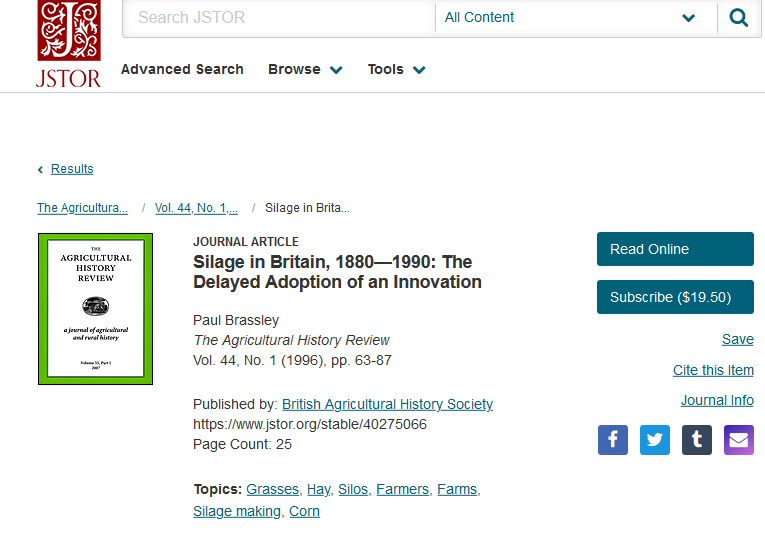Following on from yesterday and silage production and Curlews (and I am grateful to a reader for pointing me to this paper);

This graph, note the logarithmic scale of the Y-axis, shows the increase in silage production, in Great Britain, from practically nothing to rather a lot over a century or so. This will not have done anything good to the nesting success of the Curlew.

With the regard to the war on silage, we have just finalised the purchase of more fields and what I call proper oak woodland from the neighbouring farm. The fields have been used for silage and to be honest they have been immaculately looked after.
The deal is the farmer can crop these fields this year as long as they come into our control by November. He has to do a bit of work cleaning the fields from stuff we don’t want polluting on the land, but I’m excited about getting them and the woods, which differ from our oak over hazel.
We’ll do some work with fencing and punching through a ride which we started this week, the fields at the moment hold little arable plant (weeds) interest for me, but they have running the whole length on one side an embankment which does.
Our plans for at least one field is to turn it into a wet scrape habitat, maybe some islands, etc., as the farm is a hop, skip and jump from a major river and marshland we think we can attract, duck, wader and goose to these fields. A peregrine is a regular in these fields. Any farmer reading this would think we are mad to do this to fields, and maybe we are! But, I’m happy!
But, warming climate has made the growing of grass more active, and reduced the amount of other arable plants because of competition. Somehow we need to get these plants back into the landscape, increase the invertebrates and generally just give back to nature.
Re: curlew, nice if we could get them wintering on these fields again, one of the problems with their lack of breeding success is human disturbance, that’s certainly evident in the New Forest with the amount of human activity around the remaining breeding sites.
The lowland and upland fringe areas which have been sterilised by silage are naturally more productive- better soils and climate. They were capable of carrying greater densities and more productive wader nests. We are now left with the marginal upland populations- at lower densities with lower productivity. These populations are inherently vulnerable – but in the past the vulnerabilities were balanced/compensated from the adjoining lowland populations. With the removal of the entire habitat, we need to forget the “old population figures” and settle on a new, reduced baseline for all the species…….
However, it would be so much better for our environment (not just the birds, eg diffuse pollution) if we could phase out a lot of the silage cropping.
Circus, silage is most likely to stay because the benefits are so great in cattle feeding and there is no reason except what should be very rare cases.
Let’s face it anything that anyone can mention can go wrong.
The vast majority of silage is wilted to where no effluent is produced anyway
I agree that the direct silage effluent pollution has largely been stopped. The diffuse pollution is coming from the inputs and the outputs that result from the intensification. The nitrates that are used to force the grass production and the volumes of slurry that are generated then have to be disposed back to the land.
Circus, I bet the pollution from vehicles and aircraft would be many more times that from silage, the obvious answer in my opinion towards helping offset the pollution and helping wildlife would be for example a certain area in each parish to be set aside with subsidy to grow for example wild grass meadow and wild bird food.
I find it incredible that this proposal is rubbished by senior conservationists.
I understand having made thousands of tons of silage in the second half of last century all the problems for wildlife associated with it but I think as long as cattle farming is practiced in the UK then silage either grass or maize will be the fodder used.
Dennis, I think you’re answered your own question.
You and I know where this set aside problems starts and ends.
I prefer graphs that don’t use log axes – easier to interpret the scale of change. From the notes on p72 in the Brassley paper appears that the production shown is in fresh tonnes, which includes a lot of water. DM is more relevant and it would also have been informative to show some data about DM yield/ha with time or the area in grass silage production but I guess it would have been a labour of love converting from fresh lbs per cubic foot.
It would be very interesting to see an up to date account of this type – it might shine some light on the growth of the contractor industry, the work-rate of machinery, untimely operations facilitated by horsepower, soil compaction, the fall in livestock numbers, flood attribution, the impact on cancer particularly breast